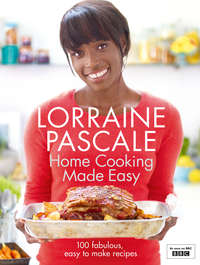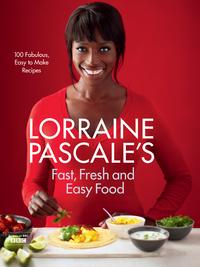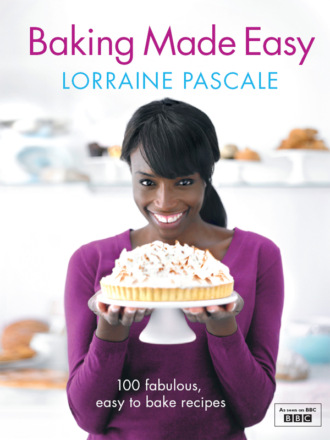
Полная версия
Baking Made Easy

Baking Made Easy
Lorraine Pascale
100 Fabulous, Easy to Bake Recipes

Contents
Title Page
Introduction
Lorraine’s Baking Tips
Chapter 1: Breads
Chapter 2: Cakes
Chapter 3: Savoury Baking
Chapter 4: Desserts & Patisserie
Chapter 5: Dinner Party
Chapter 6: Sweet Treats
Chapter 7: Basics
Searchable Terms
Acknowledgments
About the Author
Credits
Copyright
About the Publisher
Introduction
My earliest baking memory is one of me at primary school. I am five and carrying a battered old tin which contains the precious ingredients to make raspberry buns. My cookery teacher is an unexpectedly beautiful woman who looks like Marilyn Monroe. In those days, we had to provide all the ingredients – and we loved to mix and whisk vigorously – just like grown ups. We’d end up with these little rock-hard balls of dough that we’d artfully filled with raspberry jam. What an amazing feat to bake something all by yourself and then to eat it and share it proudly with your family. This was the first time I remember really appreciating food – and it was all down to baking. These classes only came round once a term but I looked forward to them more than anything else. So it was inevitable that my first cookery book would have an emphasis on baking. Writing this book really is a dream come true for me.
My heroes have always been the great female food writers Elizabeth David, Fanny Cradock, Isabella Beeton and Marguerite Patten – all extraordinary culinary visionaries whose influences are still prevalent today. Just like them, I have always wanted to find that ‘work thing’ I could feel passionate about. I enjoyed my modelling days, but I knew that it wasn’t the thing I was destined to do for ever. I was briefly a secretary, then a mechanic, an interior designer – I even wrote a book about football’s offside rule! But nothing held my attention for long. And then, by chance, I enrolled on a diploma cookery course at Leith’s School and I knew at once I was home.
I had fallen head over heels. Friends readied themselves to tease me yet again about another failed venture but this time I surprised them all. I just kept on going with the course and I ended up studying cookery, specialising in patisserie, for over a decade. I cut my teeth working in some of the country’s most respected kitchens and I worked alongside chefs who were completely committed to the pursuit of culinary perfection.
Looking back at my life, with its inevitable highs and lows, I now realise that I have always found a sense of purpose and a strength of mind when I am in the kitchen. The phone will ring and dramas will unfold outside, but cooking is where I find my peace and quiet. Time feels like it’s standing still when actually it is flying by. I believe this is called being ‘in the flow’ – when you are so passionately and happily engaged in an activity that you lose all track of time.
In my first book I wanted to offer a series of recipes to showcase the magical chemistry of baking. Recipes that would stimulate the most sophisticated of palates, but also inspire those of less-experienced bakers. My book contains a hundred of my favourites and includes both sweet and savoury, from Fig, Cream Cheese & Mint Tart and White Chocolate Pannacotta, to Trout en Papillote with Sauterne and Almonds. There’s my take on the Doris Grant Loaf, a delicious Gorgonzola & Pear Soufflé, my famous Stout & Stilton Bread Rolls, and a very wicked ‘I just don’t give a damn’ Chocolate Cake. There are simpler ideas too, like my Glam Mac & Cheese and some Totally Lazy Sausage Rolls.
I have included a whole chapter of bread recipes, because I love making bread. It must be the physical process of rhythmically kneading a compliant dough that makes it one of the most therapeutic of activities. There is an almost religious experience to be had from thoughtfully crafting a loaf and then eating it warm from the oven. Think of delightfully aromatic foccacia from Italy – salty, oily and fragrant, or a sophisticated and discerning French fougasse that is mature enough to support the flavours of molten cheese and piquant ham. Crumbly and cake-like Irish soda bread, slapped with really good butter: I dream about this. With bread, the possibilities are limitless and I’ve included new twists on many favourites.
My book would not be complete without plenty of recipes devoted to a very special ingredient – chocolate. A product so universally adored, debated and eaten deserves special attention. I wanted to give you recipes that were delightful to prepare, beautiful to gaze at, dreamy to eat. Chocolate Melting Puddings and the Chocolate & Hazelnut Tart tick all the boxes, and there’s my glorious ‘I can’t believe you made that cake’, a mountain of chocolate cigarillos and strawberries. For all true chocolate brownie aficionados, I believe I have formulated the perfect recipe – a brownie that is light in texture, high in taste and substantial in the eating.
I hope I have written a book that will stand the test of time. A book that you will not only look at and admire, but will use, again and again and again. A book that comprehensively covers all the classics, but dares to give them a twist, that sits between practical and inspiring. These recipes will take you comfortably from Monday to Friday – with enough treats besides for special occasions and those precious weekends.
Have I inspired you? I sincerely hope so. Shake out your apron, switch off that phone, shut the kitchen door firmly and ramp up the music…because now is all about baking!
Lorraine’s Baking Tips
Choosing your ingredients
Medium-sized eggs are used in all my recipes. A whole medium-sized egg weighs approximately 55g (2oz). A medium egg white weighs approx. 30g (1oz). So if you only have eggs of a different size in your kitchen, crack them into a jug and mix well, then measure out 55g for each whole egg required.
Most of my recipes use unsalted butter. However, a good-quality salted butter is okay to use (beware – the cheaper the butter, the more salt it contains). If using salted butter in cakes, omit any extra pinches of salt that are requested in the recipes.
I rarely use self-raising flour. Instead, I use plain flour and baking powder, which gives you more control over how much the cake will rise.
A good vanilla extract can make all the difference to a recipe, but for the best taste, use the seeds from actual vanilla pods. These are extremely expensive in the supermarkets, so if you do lots of baking, vanilla pods can be purchased in bulk on the internet. Instead of paying £3 for just two pods, buying in bulk can work out at as little as 12p per pod!
I never buy unwaxed lemons as they are so expensive, and not always readily available. For zest, buy ordinary lemons and wash them well in hot, soapy water. Give them a good rinse, rub them dry and the waxy coating will come off.
Tips for better baking
• Preheat your oven prior to weighing out any ingredients.
• Have all ingredients at room temperature for the best results, apart from when you need egg whites. Warm eggs are much harder to separate than cold ones, so cold, fresh eggs are best.
• Take your butter out of the fridge as soon as you get an urge to bake, as so many of my recipes call for soft butter. I’ve tried all sorts of not-so-clever quick melting solutions for too-hard butter, such as sitting it on a radiator, or placing it near the stove, but the one I fell in love with was grating it with a cheese grater into a bowl. The butter becomes instantly soft and ready to use. Genius!
• There is no need to sift flour, unless it has really clumped together or the recipe specifically states it.
• Icing sugar is normally best sifted as it does tend to clump together and may leave lumps in your buttercream.
• If possible, invest in some proper measuring spoons – a teaspoon and tablespoon are most commonly needed. These are available in most bigger supermarkets, from cookshops or online.
• When folding ingredients together, the best tool is a plastic spatula rather than a metal spoon (although this will do). Always fold the mixture slowly to retain as much air as possible.
• For safe and effective chopping, put a damp kitchen cloth underneath your chopping board to stop it sliding around.
• If attempting a pastry recipe, be aware that they aren’t the fastest recipes in the world and due to their precise nature should not be hurried. Leave yourself plenty of time.
• When flouring a board or surface for rolling pastry, make sure there’s enough flour to prevent the pastry sticking, but don’t use so much that it changes the quantities of the recipe!
• For best results, do use the size of tin or dish recommended in the recipe.
• The best way to grease tins and pans is with the vegetable oil spray often used for low-fat frying.
• Bake cakes on the middle shelf of the oven at 180°C (350°F), Gas Mark 4 unless the recipe states otherwise. Bread should be baked in the top third of the oven, while meringues need to be put near the bottom. (For meringues, you can also leave the oven door open just a fraction, which allows moisture to escape.)
• Every oven is different, so cooking times can often vary. If opening the oven to check something’s cooked, open the door, take out the item and then close the oven again quickly so that the heat does not get lost.
• To test if a cake is cooked, insert a skewer or cocktail stick into the centre of the cake – it should come out clean.
Tips for great bread-making
• If you do it right, bread-making can be the easiest thing in the world. For the very best loaves, fresh yeast is the way forward. But after it proved a challenge to buy in central London, I thought it prudent to suggest fast-action dried yeast for the recipes in this book. I know many people might have a bread maker – indeed, I was the owner of one for a spell – but I missed the tactile and magical experience that comes with being able to see every stage of the bread-making process, and I’m now a firm believer in making it by hand.
• Be brave with the water: the wetter the dough, the fluffier and lighter the loaf will be.
• Always measure out the salt precisely, as this one ingredient makes all the difference between a good-tasting loaf and a bad one. And be warned that lo-salt, whilst brilliant for other dishes, does not work well when making bread, because it doesn’t impart enough flavour and the bread will end up tasting bland.
• Accurately time the kneading process and knead the dough for the full time stated in the recipe. It really does make a difference.
• When leaving the bread to rise, it likes to be in a warm but not hot place. Most airing cupboards and tops of radiators are too warm. A warm, cosy kitchen is usually just fine.
• To test if the bread has risen enough, flour your finger and gently prod the side of the loaf. When ready, the dough should spring halfway back up.
• Once a loaf is ready to bake, there are a number of ways to ‘glaze’ it. Milk will give it a soft, matt look; eggwash will give a shiny, crunchy look; and sieving a little flour over the top will give it an authentic rustic ‘French bread’ look.
• Try to create a steamy environment inside the oven – this will give the bread plenty of time to rise up before the hard crust starts to develop. Throw some ice cubes into the bottom of the oven, use a water spray to create a mist, or put a roasting tin, half filled with water, on the bottom shelf.
• If the top of your loaf is done but the bottom is not (to check, turn it over and tap it. If ready, it will sound hollow), cover the loaf loosely with some foil to prevent it from colouring further while it finishes cooking.
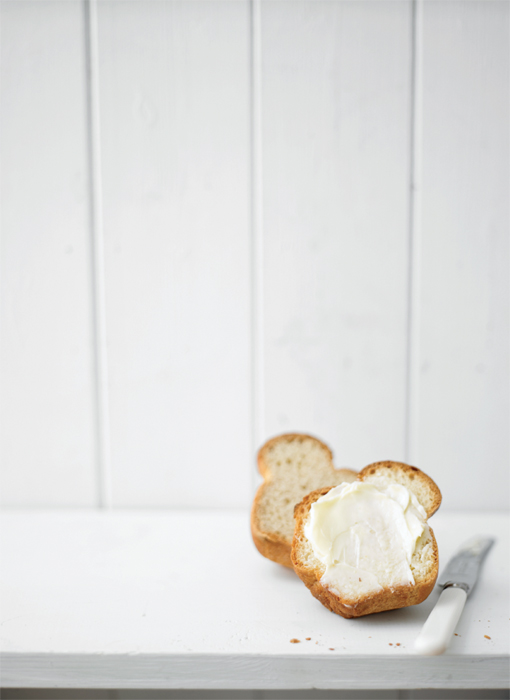
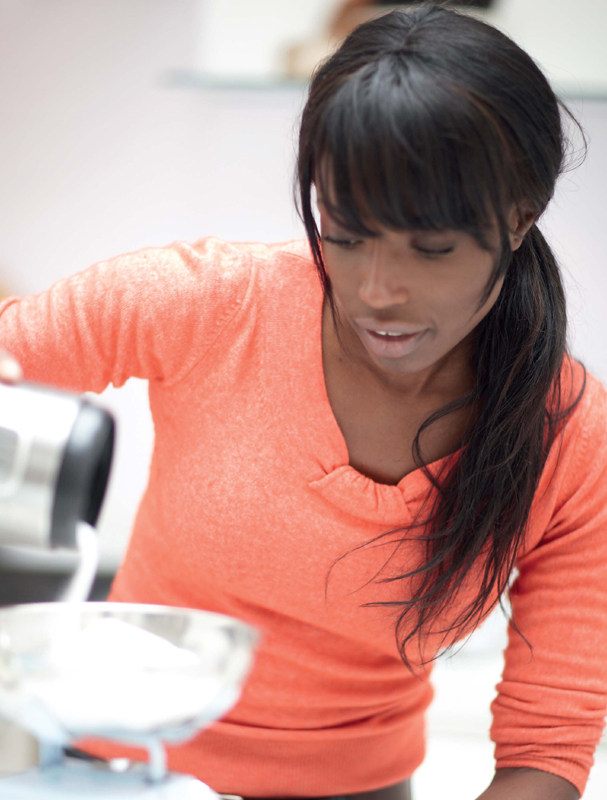
Конец ознакомительного фрагмента.
Текст предоставлен ООО «ЛитРес».
Прочитайте эту книгу целиком, купив полную легальную версию на ЛитРес.
Безопасно оплатить книгу можно банковской картой Visa, MasterCard, Maestro, со счета мобильного телефона, с платежного терминала, в салоне МТС или Связной, через PayPal, WebMoney, Яндекс.Деньги, QIWI Кошелек, бонусными картами или другим удобным Вам способом.




